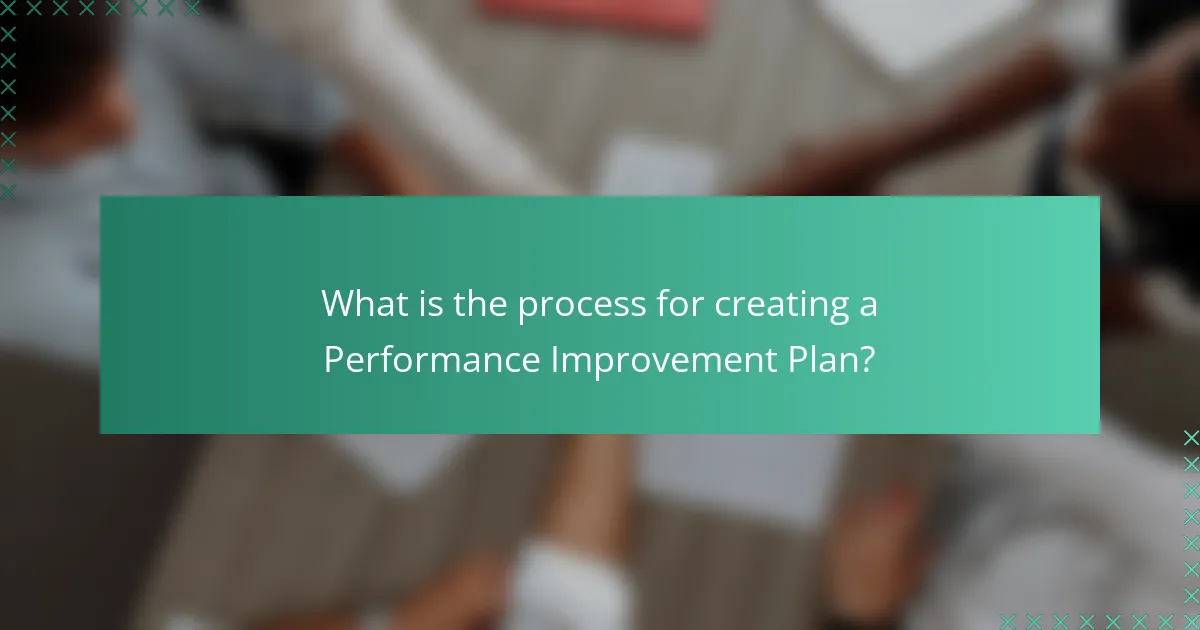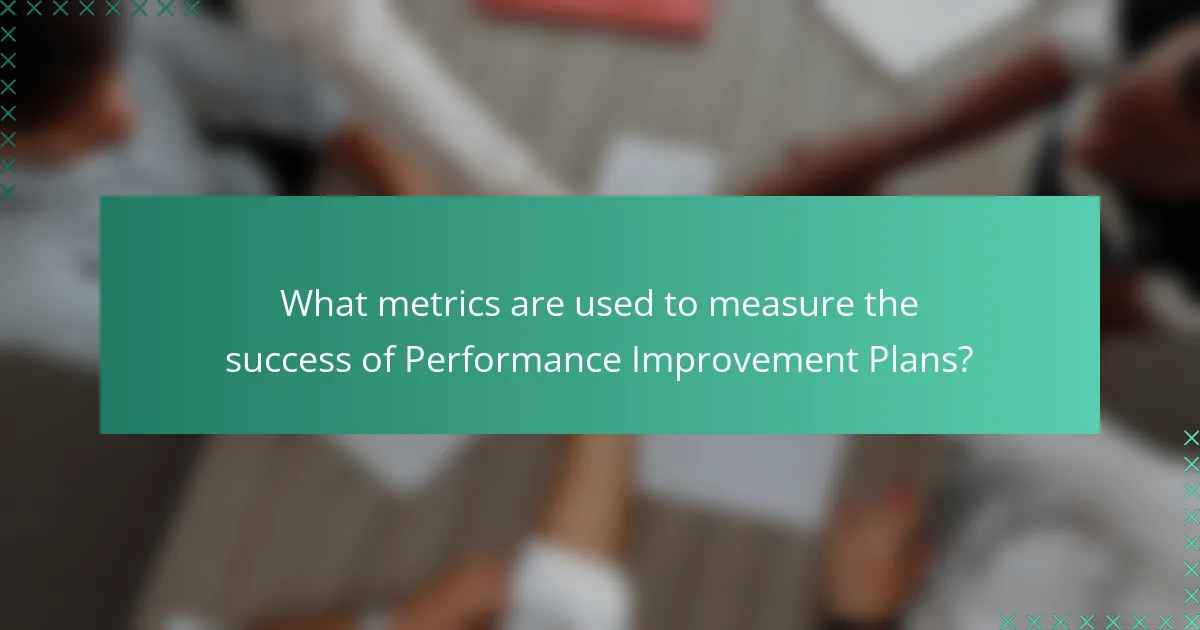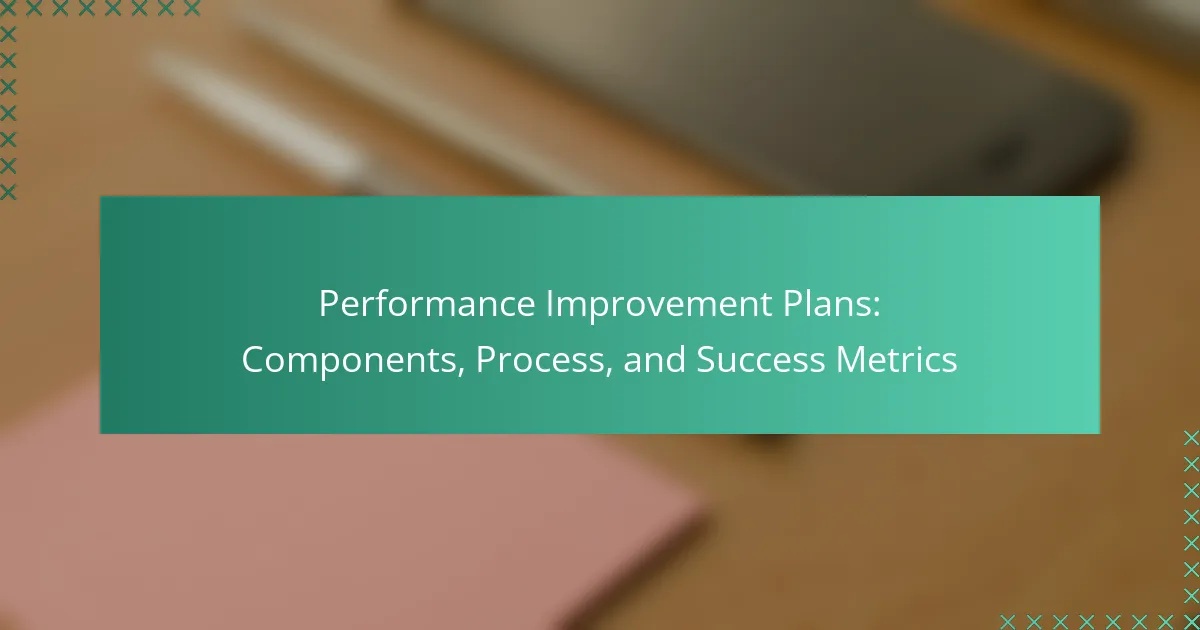Performance Improvement Plans (PIPs) are structured documents designed to enhance employee performance by identifying specific areas for improvement. The article outlines the key components of PIPs, including measurable goals, timelines, and the necessary support resources. It details the process for creating an effective PIP, emphasizing the importance of regular check-ins and documentation to ensure accountability. Additionally, the article discusses key metrics for evaluating the success of PIPs, such as employee performance ratings, goal completion, and supervisor feedback, which collectively assess the impact of PIPs on both individual and organizational performance.

What are Performance Improvement Plans?
Performance Improvement Plans (PIPs) are structured documents aimed at enhancing employee performance. They outline specific areas where improvement is needed. PIPs typically include measurable goals and a timeline for achieving them. The process often involves regular check-ins between the employee and their manager. This ensures that progress is monitored and support is provided. PIPs are commonly used when an employee’s performance falls below expectations. They serve as a formal way to address performance issues. Successful implementation can lead to improved employee productivity and morale.
How do Performance Improvement Plans function in an organization?
Performance Improvement Plans (PIPs) function as structured processes to enhance employee performance in organizations. They identify performance deficiencies and set clear expectations for improvement. PIPs typically include specific goals, timelines, and support mechanisms. Managers collaborate with employees to create these plans. Regular check-ins assess progress and provide feedback. Successful PIPs often lead to enhanced employee skills and productivity. Research shows that organizations using PIPs can improve overall performance metrics significantly.
What are the key components of a Performance Improvement Plan?
A Performance Improvement Plan (PIP) typically includes several key components. First, it outlines the employee’s performance issues clearly. This section specifies the areas needing improvement. Second, it sets measurable goals for the employee. These goals should be specific, achievable, and time-bound. Third, the PIP details the resources and support available to the employee. This may include training or mentorship. Fourth, it establishes a timeline for review and evaluation. Regular check-ins help track progress. Finally, it includes consequences for not meeting the outlined goals. These components ensure clarity and accountability in the performance improvement process.
Why are Performance Improvement Plans important for employee development?
Performance Improvement Plans (PIPs) are crucial for employee development because they provide structured guidance for performance enhancement. PIPs help identify specific areas where employees need improvement. They outline clear expectations and goals for the employee to achieve. This process encourages accountability and ownership of performance issues. PIPs also facilitate regular feedback and communication between employees and management. Research indicates that organizations using PIPs see a 30% increase in employee performance when effectively implemented. Moreover, PIPs contribute to employee retention by addressing performance issues constructively. Thus, PIPs serve as a vital tool in fostering professional growth and organizational success.
What are the common goals of Performance Improvement Plans?
The common goals of Performance Improvement Plans (PIPs) are to enhance employee performance and address specific deficiencies. PIPs aim to set clear expectations for improvement. They provide structured feedback to guide employees toward meeting performance standards. Additionally, PIPs identify resources and support available to employees. They also create a timeline for achieving goals and monitoring progress. Ultimately, PIPs seek to foster accountability and encourage professional development. These goals are essential for aligning employee performance with organizational objectives.
How do Performance Improvement Plans align with organizational objectives?
Performance Improvement Plans (PIPs) align with organizational objectives by providing a structured framework for employee development. PIPs identify performance gaps and set clear expectations for improvement. This process directly supports the organization’s goals by enhancing overall productivity. By focusing on specific skills and outcomes, PIPs ensure that employee performance contributes to strategic initiatives. Regular assessments during the PIP process allow for adjustments that keep employee efforts aligned with changing organizational objectives. Research shows that organizations implementing PIPs see a 20% increase in employee performance when aligned with strategic goals.
What specific outcomes can be expected from implementing a Performance Improvement Plan?
Implementing a Performance Improvement Plan (PIP) can lead to enhanced employee performance and productivity. It establishes clear expectations and goals for the employee. This clarity often results in improved focus and motivation. Additionally, a PIP provides structured feedback, allowing employees to understand their strengths and areas for improvement. Regular check-ins during the PIP process facilitate ongoing communication. This can strengthen the relationship between management and staff. Ultimately, successful implementation can lead to better team dynamics and organizational performance. Research shows that effective PIPs can increase employee retention rates by up to 25%.

What is the process for creating a Performance Improvement Plan?
The process for creating a Performance Improvement Plan (PIP) involves several key steps. First, identify the performance issues that need addressing. This requires gathering data and feedback on the employee’s performance. Next, set clear, measurable goals for improvement. These goals should be specific and achievable within a defined timeframe. After that, outline the support and resources that will be provided to help the employee meet these goals. This may include training, mentoring, or additional tools. Then, establish a timeline for regular check-ins to monitor progress. These check-ins should allow for adjustments to the plan as necessary. Finally, document the entire process, including the goals, resources, and timelines, to ensure accountability and clarity. This structured approach enhances the likelihood of successful performance improvement.
How do you initiate a Performance Improvement Plan?
To initiate a Performance Improvement Plan (PIP), first identify the performance issues. Clearly document specific examples of underperformance. Next, outline measurable goals for improvement. Set a timeline for achieving these goals. Communicate the plan to the employee involved. Ensure the employee understands expectations and resources available. Schedule regular check-ins to monitor progress. This structured approach is essential for effective PIP implementation.
What steps are involved in developing a Performance Improvement Plan?
Identify performance issues clearly. Gather relevant data and feedback. Set specific, measurable goals for improvement. Develop action steps to achieve these goals. Assign responsibilities for each action step. Establish a timeline for completion. Monitor progress regularly and adjust the plan as needed. Document the entire process for accountability and future reference.
Who should be involved in the Performance Improvement Plan process?
The Performance Improvement Plan process should involve the employee, their direct supervisor, and relevant HR personnel. The employee is essential as they are the focus of the plan. The direct supervisor provides insights into the employee’s performance and sets expectations. HR personnel assist with compliance and ensure the process follows company policies. Additionally, any relevant team members may be included for input on collaborative aspects. Involving these parties fosters clear communication and accountability throughout the process.
What are the best practices for executing a Performance Improvement Plan?
Establish clear objectives for the Performance Improvement Plan (PIP). Clear objectives provide direction and measurable outcomes. Communicate expectations to the employee involved. Open communication fosters understanding and accountability. Regularly monitor progress against the set objectives. Monitoring ensures timely adjustments and support. Provide constructive feedback throughout the process. Constructive feedback helps the employee understand areas for improvement. Involve relevant stakeholders in the process. Stakeholder involvement enhances support and resources. Document all steps taken during the PIP. Documentation serves as a reference and accountability tool. Evaluate the PIP’s effectiveness at the end of the period. Evaluation determines whether the objectives were met and informs future plans.
How can feedback be effectively integrated into the Performance Improvement Plan?
Feedback can be effectively integrated into the Performance Improvement Plan (PIP) by establishing clear channels for communication. Regular check-ins should be scheduled to discuss progress and challenges. This allows for timely adjustments to the PIP based on real-time observations. Specific, actionable feedback must be provided to ensure clarity in expectations. Additionally, involving employees in the feedback process fosters ownership and accountability. Utilizing performance metrics can help quantify feedback and track improvements. Implementing a structured review process ensures that feedback is consistently applied and evaluated. Research shows that organizations with effective feedback mechanisms see a 14.9% increase in employee performance (Source: Gallup).
What role does communication play in the success of a Performance Improvement Plan?
Communication is crucial for the success of a Performance Improvement Plan (PIP). It ensures clarity of expectations between management and employees. Effective communication fosters understanding of performance issues and desired outcomes. Regular updates and feedback enhance engagement in the improvement process. Clear dialogue helps identify obstacles and potential solutions. Studies show that organizations with strong communication see higher success rates in PIPs. For instance, a report by the Society for Human Resource Management indicates that effective communication increases employee performance by up to 25%.

What metrics are used to measure the success of Performance Improvement Plans?
Key metrics used to measure the success of Performance Improvement Plans (PIPs) include employee performance ratings, completion of set goals, and feedback from supervisors. Employee performance ratings assess improvements in job-related skills and productivity. Completion of set goals indicates whether the employee has met the objectives outlined in the PIP. Feedback from supervisors provides qualitative insights into changes in behavior and performance over time. Additionally, retention rates and overall team performance can reflect the effectiveness of the PIP in fostering a productive work environment. These metrics collectively help determine the impact of PIPs on individual and organizational performance.
How do you evaluate the effectiveness of a Performance Improvement Plan?
To evaluate the effectiveness of a Performance Improvement Plan (PIP), measure specific performance metrics outlined in the plan. These metrics should include clear, quantifiable goals relevant to the employee’s role. Regular check-ins can provide ongoing feedback and assess progress toward those goals. Additionally, gather qualitative feedback from supervisors and peers to understand behavioral changes. Comparing performance data before and after the PIP implementation offers concrete evidence of improvement. An effective PIP should lead to measurable enhancements in productivity and job performance. If the employee meets or exceeds the defined goals, the PIP can be deemed effective.
What specific success metrics should be tracked?
Key success metrics to track include employee performance, productivity levels, and engagement scores. Employee performance can be measured through individual goal attainment and feedback from supervisors. Productivity levels can be assessed by output rates and efficiency metrics. Engagement scores are determined through surveys that gauge employee satisfaction and commitment. Additionally, training completion rates and skill acquisition should be monitored to evaluate the effectiveness of improvement initiatives. Tracking these metrics provides insight into the overall success of Performance Improvement Plans.
How can data from Performance Improvement Plans inform future initiatives?
Data from Performance Improvement Plans (PIPs) can inform future initiatives by identifying trends in employee performance. Analyzing PIP data reveals common areas where employees struggle. This information helps organizations tailor training programs to address specific weaknesses. Furthermore, PIPs provide insights into the effectiveness of current management practices. By reviewing outcomes, organizations can refine their performance management strategies. Data-driven decisions based on PIPs enhance employee engagement and productivity. For instance, a study by the Society for Human Resource Management found that organizations using performance data saw a 20% increase in overall employee performance. This evidence supports the value of leveraging PIP data for future initiatives.
What challenges might arise during the implementation of a Performance Improvement Plan?
Challenges that might arise during the implementation of a Performance Improvement Plan include resistance from employees. Employees may feel threatened by the changes and may not fully engage with the process. Communication issues can also hinder implementation. Lack of clear messaging can lead to misunderstandings about goals and expectations. Insufficient resources, such as time and training, can impede progress. Without adequate support, the plan may not be executed effectively. Additionally, unclear metrics for success can create confusion regarding performance evaluation. Finally, leadership commitment is crucial; if leaders do not actively support the plan, it is less likely to succeed.
How can organizations overcome common obstacles in Performance Improvement Plans?
Organizations can overcome common obstacles in Performance Improvement Plans by establishing clear objectives. Clear objectives provide a roadmap for employees and managers. They help in aligning expectations and measuring progress. Regular communication is essential to address concerns and provide feedback. This fosters a supportive environment for improvement. Training and resources should be made available to enhance employee skills. Providing the right tools increases the likelihood of successful outcomes. Monitoring progress through regular check-ins ensures accountability. This helps in identifying issues early and making necessary adjustments. Lastly, involving employees in the process increases buy-in and motivation. Engaged employees are more likely to commit to improvement efforts.
What are the key takeaways for implementing effective Performance Improvement Plans?
Key takeaways for implementing effective Performance Improvement Plans include setting clear objectives, providing regular feedback, and involving employees in the process. Clear objectives ensure that performance expectations are understood. Regular feedback helps track progress and make necessary adjustments. Involving employees fosters ownership and accountability. Additionally, using measurable success metrics allows for objective evaluation of improvements. A structured timeline keeps the plan on track. Lastly, follow-up meetings reinforce commitment and facilitate ongoing support. These practices enhance the effectiveness of Performance Improvement Plans and drive employee development.
Performance Improvement Plans (PIPs) are structured documents designed to enhance employee performance by identifying specific areas for improvement, setting measurable goals, and providing a timeline for achievement. The article outlines the components of PIPs, including performance issues, support resources, and evaluation metrics, while emphasizing the importance of communication and feedback throughout the process. It also discusses the role of PIPs in aligning employee performance with organizational objectives and the potential outcomes, such as increased productivity and employee retention. Additionally, the article addresses common challenges in PIP implementation and offers best practices for ensuring their effectiveness.
